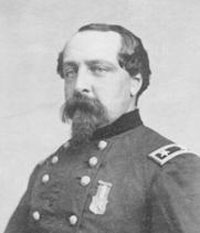
Edward Ferrero (1831-1899)
Edward Ferrero was born in Grenada, Spain, January 18, 1831. His parents were natives of Italy, and had just arrived in Spain when the son was born. Thirteen months later the family removed to the United States and settled in New York City.
The elder Ferrero's house in New York City was frequented by Italian political refugees, and he enjoyed the friendship of Garibaldi, Argenti, Albius, and Avazzana. Signor Ferrero, who was famed as a dancer, opened a dancing school at what is now the northeast corner of Fourteenth Street and Sixth Avenue, which, as the years went by, became the most famous in the country.
Edward was reared practically on the floors of the dancing academy among the boys and girls of the wealthiest families of New York. He developed into a master of the Terpsichorean art, and when his parents retired, in the early fifties, he succeeded to the business. He originated many dancing figures which became popular throughout this country and Europe.
His establishment was patronized by the most exclusive families, and many elderly members of the leading families of the New York of to-day took their first dancing lessons under his tutelage. He also found to teach dancing at in the Military Academy at West Point. He always had a taste for military life, and at the beginning of the civil war was Lieutenant Colonel of the Eleventh New York Militia Regiment.
When war was declared he promptly left the polished floors of the dancing halls for the field of sterner action. In 1861 he raised the Fifty-first New York Regiment, called the "Shepard Rifles," of which he was made Colonel. He led a brigade in Burnside's expedition to Roanoke Island, where his regiment took the first fortified redoubt captured in the war.
He also commanded a brigade at Newbern under Gen. Reno, and in 1862 served in Pope's Virginia campaign. He was in the battles of South Mountain and Antietam, and for his bravery in the latter was commissioned Brigadier General of Volunteers on September 19, 1862. He served at Fredericksburg and Vicksburg, and commanded a division at the seige of Knoxville.
The ex-dancing master afterward marched the Ninth Army Corps over the mountains without roads and by compass only to Cincinnati. He was in command at the defense of Fort Sanders against the desperate assault of Longstreet. In Grant's final campaign, including the seige of Petersburg, he commanded the colored division of the Ninth Army Corps, and on December 2, 1864, he was breveted Major General for "bravery and meritorious services."
He was mustered out August 24, 1865, and upon returning to New York did not reopen his dancing school, but leased a building at Twenty-eighth Street and Broadway, now the site of the Fifth Avenue Theatre, and converted it into a splendid ballroom, which was known as Apollo Hall. In this hall were held the greatest balls and other social gatherings of the exclusive social set. The site finally became too valuable for a ballroom, and in 1872, Gen. Ferrero gave up his lease, and the building was converted into a theatre.
Gen. Ferrero next leased the big ballroom of Tammany Hall. He joined the Tammany Society, and became known personally to nearly every Democratic politician of note in the State. He never took much interest in politics, however, and never held an office. When the old Monitor and Merrimac Exposition Building, at Fifty-ninth Street and Madison Avenue, was converted into the Lenox Lyceum he gave up the Tammany Hall lease and took charge of the Lyceum Jan. 1, 1889. He held this until May 1899, when he retired. He died in December 1899.
Notwithstanding his hard campaigns and marches in the civil war, Gen. Ferrero retained the polished manner and grace of carriage acquired in early life. He was a member of the Loyal Legion, the Grand Army of the Republic, and Manhattan Lodge of Masons.